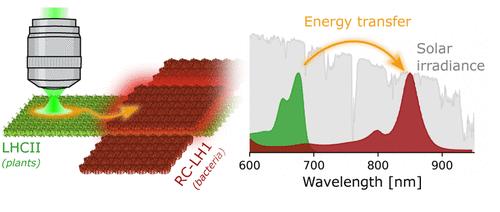集成纳米级平台中激子扩散增强的能量捕获
IF 16
1区 材料科学
Q1 CHEMISTRY, MULTIDISCIPLINARY
引用次数: 0
摘要
通过生物启发的纳米级平台利用太阳能为可持续能源转换提供了一条有前途的途径。生物杂交系统利用了自然系统的设计和性能,同时也优化了蛋白质成分的组织。到目前为止,这样的系统通常是由同一物种的组成部分组成的,这限制了可以产生的特性和相互作用的范围。在这里,我们介绍了一个包含跨物种天线/反应中心蛋白的生物分子膜的纳米级平台。我们展示了来自绿色植物的天线光收集复合物II (LHCII)的远程激子扩散约200 nm,并使用互补模拟量化了3 × 10-2 μm2 ns-1的潜在扩散率。LHCII微图案还诱导定向激子扩散,作为增强能量捕获的关键机制,为紫色细菌的反应中心-光收集复合物1提供了约30%的能量传递效率。该平台为可操作的混合能量收集系统提供了概念验证,该系统能够跨越整个可见光谱。将多种光合作用蛋白整合到生物膜平台中,为太阳能捕获和转化提供了新的潜力。本文章由计算机程序翻译,如有差异,请以英文原文为准。

Exciton-Diffusion Enhanced Energy Capture in an Integrated Nanoscale Platform
Harnessing solar energy through biologically inspired nanoscale platforms presents a promising route for sustainable energy conversion. Biohybrid systems take advantage of the design and performance of natural systems while also enabling the optimized organization of the protein components. Until now, such systems have usually been made from components of the same species, limiting the range of properties and interactions that can be generated. Here, we introduce a nanoscale platform of biomolecular films containing cross-species antenna/reaction center proteins. We demonstrated a long-range exciton diffusion of ∼200 nm through the antenna light-harvesting complex II (LHCII) from green plants and quantified the underlying diffusivity at 3 × 10–2 μm2 ns–1 using complementary simulations. The LHCII micropattern also induced directional exciton diffusion as a crucial mechanism for enhanced energy capture, yielding a ∼30% energy transfer efficiency to the reaction center-light-harvesting complex 1 complex from purple bacteria. This platform provides a proof-of-concept for an operation-ready, hybrid energy harvesting system capable of spanning the entire visible spectrum. The integration of diverse photosynthetic proteins into biofilm platforms offers new potential for solar energy capture and conversion.
求助全文
通过发布文献求助,成功后即可免费获取论文全文。
去求助
来源期刊

ACS Nano
工程技术-材料科学:综合
CiteScore
26.00
自引率
4.10%
发文量
1627
审稿时长
1.7 months
期刊介绍:
ACS Nano, published monthly, serves as an international forum for comprehensive articles on nanoscience and nanotechnology research at the intersections of chemistry, biology, materials science, physics, and engineering. The journal fosters communication among scientists in these communities, facilitating collaboration, new research opportunities, and advancements through discoveries. ACS Nano covers synthesis, assembly, characterization, theory, and simulation of nanostructures, nanobiotechnology, nanofabrication, methods and tools for nanoscience and nanotechnology, and self- and directed-assembly. Alongside original research articles, it offers thorough reviews, perspectives on cutting-edge research, and discussions envisioning the future of nanoscience and nanotechnology.
 求助内容:
求助内容: 应助结果提醒方式:
应助结果提醒方式:


